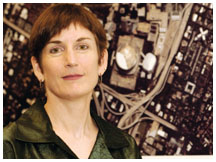
|
|
October 19, 2005: A moment with...
(Jackson Hill/Black Star) |
Elizabeth English ’75
Within days of Hurricane Katrina’s devastating blow to New Orleans, Elizabeth English ’75 headed into the city to inspect the damage. An associate professor at Louisiana State University’s Hurricane Center in Baton Rouge, English toured the Ninth Ward in a boat and picked up abandoned pets that she later delivered to an animal shelter in Baton Rouge. English, an architect and structural engineer, spoke with PAW’s Katherine Federici Greenwood about three weeks after the storm.
What’s next for New Orleans? Should the devastated areas be rebuilt?
There’s a lot of controversy about that. Part of New Orleans’ character is its architecture. So while the most sensible approach for ordinary houses might be to come in and bulldoze an area that has suffered what the Ninth Ward has suffered, that may not be an appropriate response here. For one thing, we need to find out just how bad the contaminants are, how much toxin there was in the water, how much toxin permeated construction materials, and that sort of thing. It’s very possible that exterior and interior surfaces could be removed and the remaining structural material be treated and the houses reconstructed. We also don’t know how much of the population is going to return, whether new populations are going to come in, or what the situation will be with the economic redevelopment.
But I think there could be ways of redeveloping that land. Perhaps it could be parkland. It might be possible to relocate some of the neighborhoods, move buildings. If a number of residents come back and want to reconstruct their neighborhoods, it might be possible to do that. I don’t mean just going in and putting up modern construction that looks kind of like it once did, and telling people that they can move in there. We don’t want to re-create New Orleans as a Disney World version of New Orleans.
When people say there’s no way we can’t rebuild, is that an emotional response?
Initially it was a gut emotional response before people even knew the extent of the damage. But what we are seeing is that, yes, there are huge amounts of damage, but the city wasn’t wiped out. It’s not like you are starting from nothing. When I got into the city I saw that there are sizable portions of the city that haven’t suffered devastating damage. There’s absolutely no reason that people wouldn’t recover those areas. And then [those areas] become the base for expanding into the areas that have suffered greater damage.
If neighborhoods are rebuilt, how do you make them safe?
They could put in buildings that had parking on the ground floor and then residential or commercial farther above ground. One good example of this is some of what I saw in Pensacola, Fla., after Hurricane Ivan. As a result of Hurricane Andrew, Florida changed its building codes. I saw a number of beachfront homes that had been built in a significantly different way, and they withstood Hurricane Ivan quite well as a result.
In July 2004, you participated in the “Hurricane Pam” simulation that was meant to prepare response teams for a major storm. What did you learn from that experience?
I told everybody I knew that if there ever is a request for evacuation, heed it — don’t fool around. One of the benefits of that Hurricane Pam exercise was that an awful lot of people who hadn’t been taking the hurricane warnings as seriously as they should have woke up. At the time of Hurricane Pam, we predicted that only 60 percent of the people would leave, because New Orleanians typically do not evacuate. People get complacent. But as a result of publicity following the Hurricane Pam exercise, people heard how vulnerable the city was. So instead of only 60 percent evacuation, we got 80 percent evacuated, and that saved a lot of lives.
You have said that New Orleans is like no other city in the United States. What do you mean?
It has a very different sensibility. New Orleanians know that the city
is in a bowl and the levees hold the water back and hurricanes are a threat.
But life goes on. The sensibility of New Orleans is to live for today.
From a Northeastern, New England perspective, New Orleans would be characterized
as having a self-indulgent, hedonistic approach to life. But that’s
another culture on the outside looking in, making judgments. The residents
of New Orleans have an extraordinary loyalty to their city. So an awful
lot of people from New Orleans are not going to care that there will be
more hurricanes threatening the city. New Orleans is where they live and
where their hearts live, and they’re going to be in New Orleans.
And if they have to leave when hurricanes are coming, then they’ll
leave — but they will go back. ![]()

